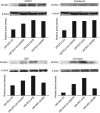Identification of chemoresistant factors by protein expression analysis with iTRAQ for head and neck carcinoma
- PMID: 25032734
- PMCID: PMC4134508
- DOI: 10.1038/bjc.2014.395
Identification of chemoresistant factors by protein expression analysis with iTRAQ for head and neck carcinoma
Abstract
Background: Cisplatin and other anticancer drugs are important in the treatment of head and neck squamous cell carcinoma; however, some tumours develop drug resistance. If chemoresistance could be determined before treatment, unnecessary drug administration would be avoided. Here, we investigated chemoresistance factors by comprehensive analyses at the protein level.
Methods: Four human carcinoma cell lines were used: cisplatin-sensitive UM-SCC-23, UM-SCC-23-CDDPR with acquired cisplatin resistance, naturally cisplatin-resistant UM-SCC-81B, and UM-SCC-23/WR with acquired 5-fluorouracil resistance. Extracted proteins were labelled with iTRAQ and analysed by tandem mass spectrometry to identify resistance. Protein expression was confirmed by western blotting and functional analysis was carried out using siRNA.
Results: Thirteen multiple-drug resistance proteins were identified, as well as seven proteins with specific resistance to cisplatin, including α-enolase. Differential expression of these proteins in cisplatin-resistant and -sensitive cell lines was confirmed by western blotting. Functional analysis for α-enolase by siRNA showed that cisplatin sensitivity significantly was increased in UM-SCC-81B and slightly in UM-SCC-23-CDDPR but not in UM-SCC-23/WR cells.
Conclusions: We identified proteins thought to mediate anticancer drug resistance using recent proteome technology and identified α-enolase as a true cisplatin chemoresistance factor. Such proteins could be used as biomarkers for anticancer agent resistance and as targets of cancer therapy.
Figures







References
-
- Blachley JD, Hill JB. Renal and electrolyte disturbances associated with cisplatin. Ann Intern Med. 1981;95:628–6632. - PubMed
-
- Boring CC, Squires TS, Tong T. Cancer statistics 1993. CA Cancer J Clin. 1993;43:7–26. - PubMed
-
- Chang YS, Wu W, Walsh G, Hong WK, Mao L. Enolase-alpha is frequently down-regulated in non-small cell lung cancer and predicts aggressive biological behavior. Clin Cancer Res. 2003;9:3641–3644. - PubMed
-
- Chang GC, Liu KJ, Hsieh CL, Hu TS, Charoenfuprasert S, Liu HK, Luh KT, Hsu LH, Wu CW, Ting CC, Chen CY, Chen KC, Yang TY, Chou TY, Wang WH, Whang-Peng J, Shih NY. Identification of alpha-enolase as an autoantigen in lung cancer: its overexpression is associated with clinical outcomes. Clin Cancer Res. 2006;12:5746–5754. - PubMed
Publication types
MeSH terms
Substances
LinkOut - more resources
Full Text Sources
Other Literature Sources
Medical
Research Materials

